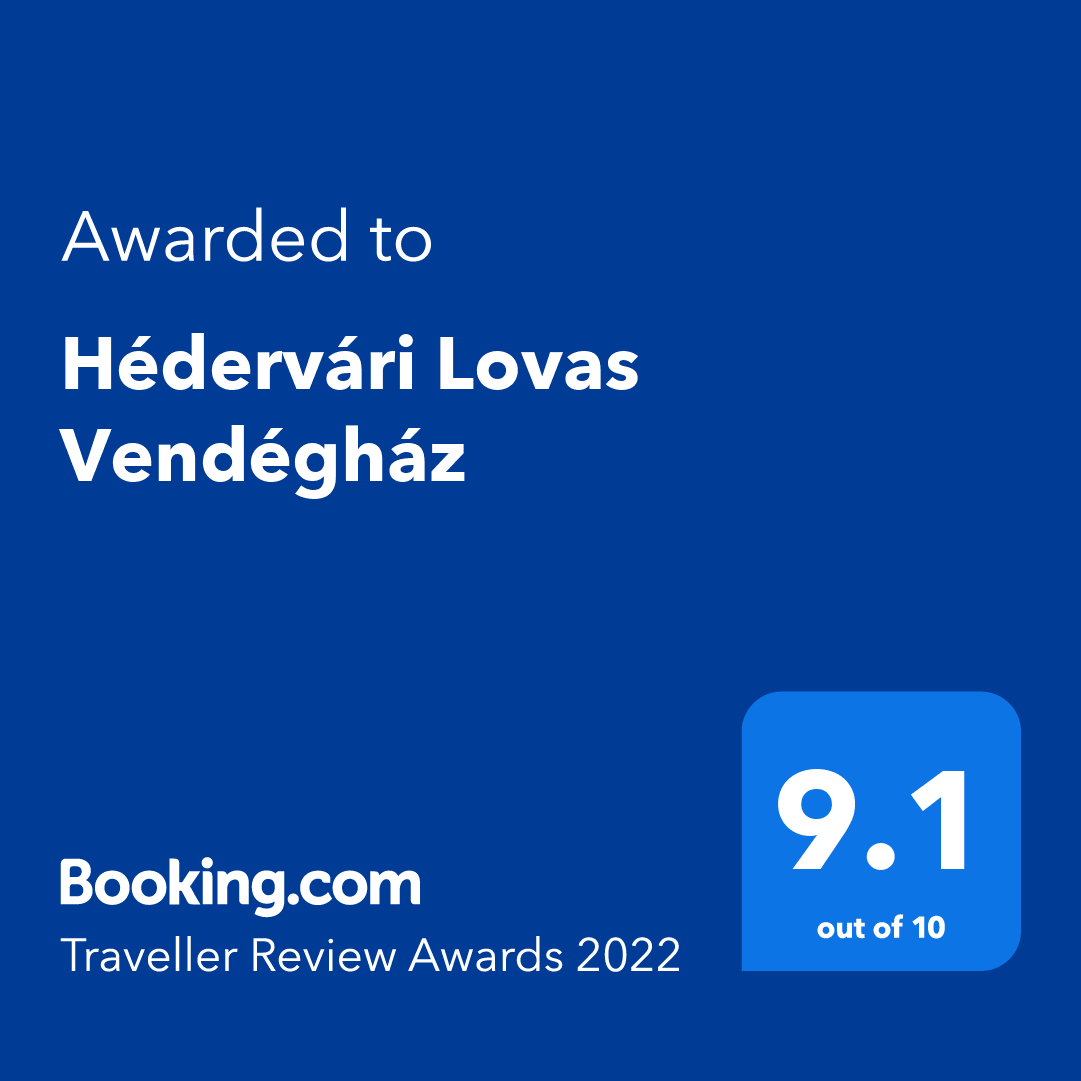Programs in Austria
Sights:
Halbturn castle (distance from Hédervár: 57 km)
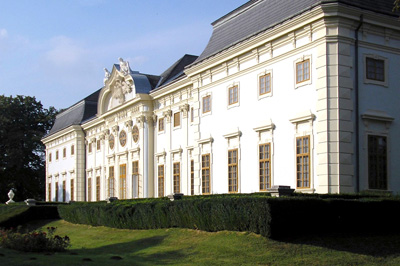 A halbturni kastély Burgenland legjelentősebb barokk építménye, amely egykoron a Habsburg császári udvar vadászkastélyaként és nyári rezidenciájaként működött. Egy séta a kastély környékén igazán romantikus páros program.
A halbturni kastély Burgenland legjelentősebb barokk építménye, amely egykoron a Habsburg császári udvar vadászkastélyaként és nyári rezidenciájaként működött. Egy séta a kastély környékén igazán romantikus páros program.Maria Theresia acquired the castle in 1765 and gave it to her favourite daughter archduchess Marie Christine when she married Duke Albert-Casimir von Sachsen-Teschen. Today the castle is the private property of one of the descendants of the emperor’s family, baron Paul Waldbott-Bassenheim. The castle is open to the public, they organize exhibitions and concerts here and a part of the castle serves as a museum.
Inside the castle, the walls and the ceiling is decorated by frescos made by Maulbertch. Since all furniture and treasures have been robbed through history’s tempestuous years, only temporary exhibitions are organized in the halls of the castle. The theme of the exhibitions changes every year. The whole castle burnt down in 1949, but they managed to save the fresco in the salon. The other parts of the castle were rebuilt in contemporary style.
The castle originally had a French formal garden, but this does not exist anymore. Visitors can see a landscape-garden created by the main gardener of the Schönbrunn castle, Anton Umlauft.
Chocolate factory in Kittsee (distance from Hédervár: 58 km)
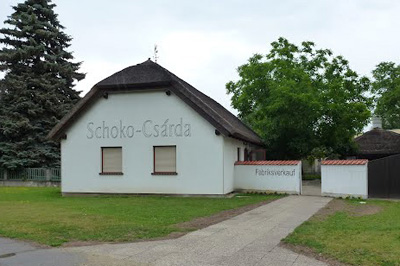 Franz Hauswirth opened his confectionery in Gablenz street in 1949. This was the predecessor of the Hauswirth company. Soon after they started to produce figurines made of chocolate. These figurines (e.g. Easter bunnies) have paved the owner’s way to the big supermarket chains that were starting to emerge at that time. Chocolate manufacturing slowly took over the whole factory’s production and there was little time for traditional confectionery products. So finally they gave up the production of confectionery products. Continuous development has also led to continuous growth, so at the beginning of the ‘60s they relocated production to Franz Hauswith’s home village in Kittsee, Burgerland. By now, Hauswirth has become the biggest producer of seasonal chocolate products.
Franz Hauswirth opened his confectionery in Gablenz street in 1949. This was the predecessor of the Hauswirth company. Soon after they started to produce figurines made of chocolate. These figurines (e.g. Easter bunnies) have paved the owner’s way to the big supermarket chains that were starting to emerge at that time. Chocolate manufacturing slowly took over the whole factory’s production and there was little time for traditional confectionery products. So finally they gave up the production of confectionery products. Continuous development has also led to continuous growth, so at the beginning of the ‘60s they relocated production to Franz Hauswith’s home village in Kittsee, Burgerland. By now, Hauswirth has become the biggest producer of seasonal chocolate products.They have always tried to satisfy their customers, therefore have always worked with state-of-the-art machines and technology. Their products are made by skilful hands and are based on old recipes. The company uses more than 2.000 tons of chocolate every year to produce their delicious and high quality products in excellent quality.
There is also a showroom at the factory. There are piles of different types of chocolate packed in batches of kilo and half a kilo. Some boxes are open so that visitors can taste and choose the flavour that suits them most.
Hainburg (distance from Hédervár: 65 km)
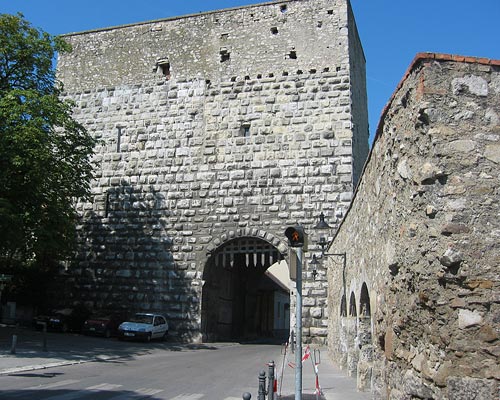 Hainburg is situated on the right side of the Danube, between Vienna and Bratislava, in the so called industrial district, 20 km from Bruck an der Leitha. It is the most eastern city of Austria, an excellent place for romantic walks.
Hainburg is situated on the right side of the Danube, between Vienna and Bratislava, in the so called industrial district, 20 km from Bruck an der Leitha. It is the most eastern city of Austria, an excellent place for romantic walks.The ruins of the old castle are mentioned in the Song of the Nibelungs. This is where Attila spent the night of his wedding with Krimhilda. At the time of the Roman Empire, the settlement was a part of Carnuntum, main settlement of Pannonia. There were huge fortifications here at that time. In the 13th century the Habsburgs acquired it.
The castle provides beautiful view of the national park and the surrounding forests near the Danube. The chapel of the castle was the place where the king of Bohemia, Premysl Otakar, and Margarete of Austria princess of Babenberg married in 1252. Small restaurants and pubs provide excellent opportunity for relaxing. There is a wide variety of cultural programmes and natural sites: historical market of the city, concerts of the Haydn-Gesellschft association etc.
The gates of the city: Vienese gate, Hungarian gate, Fisher’s gate. The Vienese gate is the most famous gate in Austria. It was built in the 13th century. There are statues of two knights guarding the gate. The Hungarian gate was also built in the 13th century. There are two fairy creatures’ sculptures for decoration. The Fisher’s gate is a four storey high gate-tower.
Carnuntum Archaeological Park (distance from Hédervár: 73 km)
 Carnuntum used to be the capital city of Pannonia province, then the capital of Pannonia superior. It was a military camp and civil town in ancient times. It is situated to the east from Vienna, in Lower-Austria province, next to the settlements Petronell-Carnuntum and Bad Deutsch-Altenburg. Visitors to the Carnuntum Musem can experience a time travel to Roman times. Emperor Tiberius established a campsite fortified by walls. This was a military camp, but it created an important town as well.
Carnuntum used to be the capital city of Pannonia province, then the capital of Pannonia superior. It was a military camp and civil town in ancient times. It is situated to the east from Vienna, in Lower-Austria province, next to the settlements Petronell-Carnuntum and Bad Deutsch-Altenburg. Visitors to the Carnuntum Musem can experience a time travel to Roman times. Emperor Tiberius established a campsite fortified by walls. This was a military camp, but it created an important town as well.Items found during archaeological excavations started in the second half of the 19th century are exhibited at the Archaeological Park Carnuntum. The treasury of Carnuntum was designed by Friedrich Ohmann. The museum was inaugurated by Emperor Franz Josef in 1904.
Visitors can see unique items from the ancient Carnuntum. All exhibited jewellery, everyday objects, weapons as well as religious items were carefully reconstructed in order to evoke the wonderful times of the Roman Empire. Visitors can also see the ruins of the ancient civil town, ruins of the Diana church, ruins of the Great Bath, as well as the castle of the governor and ruins of the garnison of the governor’s guards.
Esterházy-castle in Eisenstadt (distance from Hédervár: 87 km)
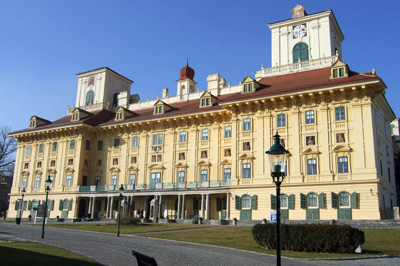 Origins of the Esterházy-castle date back to the original castle built here in the 13th century. Nowadays it houses cultural events and provides a glimpse at the life of the noble society and dukes of Esterházy.
Origins of the Esterházy-castle date back to the original castle built here in the 13th century. Nowadays it houses cultural events and provides a glimpse at the life of the noble society and dukes of Esterházy.The Esterházy-castle houses several exhibitions. Visitors have the opportunity to see the quarters of the duchess, but the main attraction of the castle is the Haydn exhibition as well as the wine museum. The lives of the following ladies are presented: Maria Josefa Hermenegilda (1768-1845), the wife of Esterházy Miklós II; Maria Theresia (1794-1874), wife of Esterházy Pál Antal III; Lady Sarah Frederica (1822-1853), wife of Esterházy Miklós III. Sources presented are: portraits, diaries, personal correspondence, economic documents and reports of contemporary people.
The main attraction of the visit is the most exciting, monumental and special fresco-series from the countries of the Hungarian Crown. The series was made in the 17th century and can be seen in the Haydn Hall. The halls of the castle present three centuries in the life of the dukes of Esterházy, full of architecture, history, and love of art. The eastern wing of the castle houses a temporary exhibition presenting treasures collected by the dukes.
The successful exhibition entitled „Haydn explosiv” organised in the Haydn-year will be continued throughout this year as well. New and borrowed items are exhibited. These new items provide guidance to the fantastic world of operas of the 18th century. The castle’s 330 year old cellar houses Austria’s greatest wine museum. More than 700 exciting items are exhibited. Visitors are guided through the long tradition, history and culture of viticulture in Burgenland.
Familypark Neusiedlersee (distance from Hédervár: 87 km)
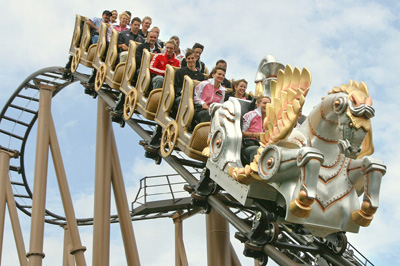 The family park is the biggest amusement and fairy park in Austria stretching over an area of more than 140,000 m². The Märchenpark, as local’s call it, contains the centre, an amusement park, a mini-zoo and a fairy tale forest which provide for entertainment for all members of the family for the whole day.
The family park is the biggest amusement and fairy park in Austria stretching over an area of more than 140,000 m². The Märchenpark, as local’s call it, contains the centre, an amusement park, a mini-zoo and a fairy tale forest which provide for entertainment for all members of the family for the whole day.The train, crocodile water-course, sand-pile, playground, fairy-tale forest, animal petting zoo provide for unforgettable moments for children. For those brave enough there is the hot-air balloon, merry-go-round, huge slide, roman tower, water-world, and roller-coaster. The roller-coaster can carry 18 people to heights of up to 16 meters, with fast curves on the 480 meter long course. The roller-coaster can catch speeds of up to 60 km/hour.
All the different vehicles, climbing facilities, electronic theatres, and the colourful variety of fairy tales and restaurants are centred around four major themes. The Amusement castle is full of dragons and a quacking duck-parade, little children can listen to colourful and nice stories in the Fairy tale forest. The “Flying Fish” is Austria’s most exciting water-marry-go-round. Children fly along pirate-bears in the company of fish who sing until they get to the Kroko-Wasserbahn. The Peasant’s Home is an excellent opportunity for a walk through the forest, where visitors have the chance to experience the beauty of nature. Visitors can spoil the animals in the zoo with delicious snacks.
Hundertwasser Museum (distance from Hédervár: 101 km)
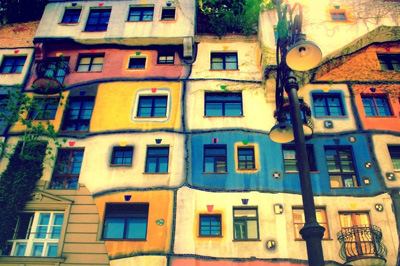 The painter and architect Friedensreich Hundertwasser (1928-2000) brought new impulse to architecture in Vienna with his characteristic style, instantly recognizable by its colourful surfaces, uneven and irregular forms full of green plants in and out. He also created an exhibition centre. The exhibition-centre houses permanent exhibitions presenting the master’s own creations. There are also temporary exhibitions, where contemporary artist present their works to visitors.
The painter and architect Friedensreich Hundertwasser (1928-2000) brought new impulse to architecture in Vienna with his characteristic style, instantly recognizable by its colourful surfaces, uneven and irregular forms full of green plants in and out. He also created an exhibition centre. The exhibition-centre houses permanent exhibitions presenting the master’s own creations. There are also temporary exhibitions, where contemporary artist present their works to visitors.Hundertwasser bought the Thonet furniture factory, which was closed earlier, and reconstructed it according to his own style. The building was opened for visitors in 1991. On two of the floors there is a permanent Hundertwasser exhibition, on two others there are temporary exhibitions. Visitors can enjoy the services of a café and a store on the ground floor.
Close to the Kunst Haus, visitors can see the Hundertwasser-building, which is the most unusual building in Vienna. The Hundertwasser-building (in German: Hundertwasserhaus) is a block of flats situated in the 3rd district of Vienna, Kegelgasse street number 34-38.
The house was built in the period between 1983 and 1986 by Joseph Krawina and Peter Pelikan. Its novelty is the waving, uneven floor, the roof was covered with grass and huge trees grow out of the rooms with their branches hanging out the windows. Hunderwasser did not accept any payment for designing the house. There are 52 apartments, 4 offices, 16 private and 3 public terraces as well as a total of 250 trees and bushes within the building. The Hundertwasser-building is one of the most popular buildings in Vienna. It has become an important part of Austria’s cultural heritage.
Schönbrunn zoo and castle (distance from Hédervár: 109 km)
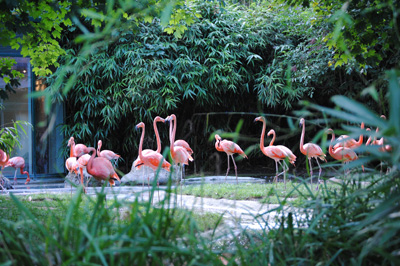 Schönbrunn zoo was the first permanent zoo in the world. It is also the only surviving and preserved baroque zoo in the world. Schönnbrunn zoo as part of the Schönbrunn castle is a World Heritage Site.
Schönbrunn zoo was the first permanent zoo in the world. It is also the only surviving and preserved baroque zoo in the world. Schönnbrunn zoo as part of the Schönbrunn castle is a World Heritage Site.Maria Theresia loved Schönbrunn castle and its garden ever since her childhood. She established her residence here in 1740, so Schönbrunn became the centre of life in the court. In the period between 1744 and 1765 she had the castle enlarged and rebuilt in rococo style based on plans made by Nikolaus Pacassi.
Her husband, Franz Stephan von Lothringen, was a devoted lover of nature. He worked a lot on the development of the garden. He also established the zoo in the backyard of the castle. He welcomed his first noble guests in the zoo on 31st of July 1752. He bought the first animals for the zoo from Prince Eugen de Savoy, who had a small collection of animals at Belvedere castle in Vienna. Based on orders of the monarchs, ambassadors and travelling merchants bought several other animals for the zoo.
At the beginning there were only a few animals in cages kept for the amusement of the family as well as for some exclusive guests. Soon after, in 1780, the establishment was opened for all “properly dressed” visitors.
On 14th of July 1906, it was the first time ever that an elephant baby was born in captivity. Before the birth of this baby elephant in Schönbrunn zoo, zoologists all around the world were convinced that elephants do not reproduce in captivity.
By 1914, the zoo had more than 3400 animals, but the facility was close to being closed after the First World War due to financial reasons. A fund raising charity by the inhabitants of Vienna prevented the zoo from being closed; however an entrance fee for visitors was introduced. WWII also caused huge losses to the zoo, and suggestion was made for the zoo to be closed.
In 1991 a company has taken over the management of the zoo and Helmut Pechlaner was appointed as director. The number of visitors began to grow and several buildings (terrarium and aquarium, bird-house, elephant park, outlet for the big cats, and the Australia-house) were built from the ever increasing incoming funds. On the 250th anniversary of the zoo, the rainforest-house was inaugurated, and an exhibition was organized in the Naturhistorisches Museum about the history of the zoo.
Nowadays, Schönbrunn zoo is one of the most modern zoos in the world, while they still managed to keep its parklike character. Its area has increased to 17 hectares, but is still in full harmony with the castle’s garden that is right next to it: the wide outlets are surrounded and separated by stretches of lawn, flowers, small lakes and trees.
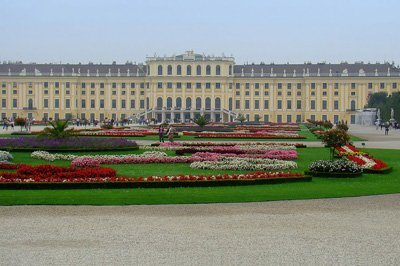 Schönbrunn castle is a baroque style residence of the imperial family. The castle is situated in the Hietzing district of Vienna. This is the most popular monument and touristic attraction in Austria.
Schönbrunn castle is a baroque style residence of the imperial family. The castle is situated in the Hietzing district of Vienna. This is the most popular monument and touristic attraction in Austria.The rooms and spaces of the castles served not only as the home of the emperor and his family, but also as a representative building where several festivities and events took place. It symbolized the strength, power and prestige of the monarchy. In order to achieve the highest degree of elegance, some of the most outstanding artists and masters were called to contribute to the building works with their artworks. Internal design of the rooms shows a harmonic amalgam of different styles like the baroque, rococo as well as biedermeier.
The first floor of the western wing houses the quarters of the emperor and the empress (Franz Ferdinand I and Empress Elisabeth). The eastern wing houses the quarters of Maria Theresia as well as the so called Franz Karl quarters. The parents of the emperor, Archduke Franz Karl and Archduchess Sophie spent their everyday life here.
Out of the hundreds of rooms in the castle the apartments of the imperial family are the most spectacular. Most of these rooms are open to the public. Some parts of the castle are still used as flats rented by the local government.
The castle is a UNESCO world heritage site.
Prater (distance from Hédervár: 103 km)
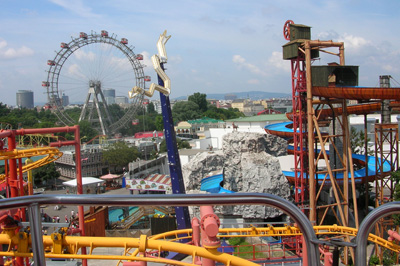 It is the amusement park of the plain people, for some it is a nostalgic place where dreams are born, a green oasis accessible for everyone and this is also the place where one of the most famous emblems of Vienna, the huge Ferris-wheel can be found. Vienna Prater has its main season in the period between March and October. The famous Ferris wheel and some other attractions are available for visit all through the year.
It is the amusement park of the plain people, for some it is a nostalgic place where dreams are born, a green oasis accessible for everyone and this is also the place where one of the most famous emblems of Vienna, the huge Ferris-wheel can be found. Vienna Prater has its main season in the period between March and October. The famous Ferris wheel and some other attractions are available for visit all through the year.
Stephansdom (distance from Hédervár: 104 km)
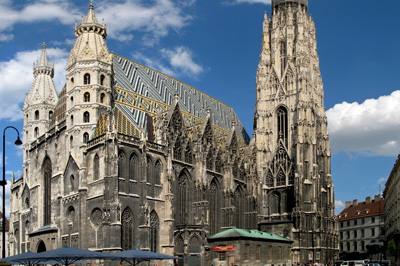 Stephansdom is one of the emblems on Vienna and Austria’s most important gothic building. It houses many treasures, most of which can only be visited with a guide.
Stephansdom is one of the emblems on Vienna and Austria’s most important gothic building. It houses many treasures, most of which can only be visited with a guide.Some of the most important monuments are the sarcophagus of Emperor Friedrich III made of red marble by Niclas Gerhaert van Leyden, or the pulpit made by Anton Pilgram around 1500, as well as the footing of the organ in the northern side-nave made also by the famous master. We can discover the master’s self-portrait on both works.
It is also worth to see the Neustadter Altar, which is a gothic altar from 1447, as well as Eugene of Savoy’s sepulchre made in 1754.
Hofburg (distance from Hédervár: 105 km)
 The Hofburg was originally a castle from the middle ages, but only the castle’s chapel survived as a remainder of that age. As the empire of the Habsburgs grew, the pompous residence grew with it. Nowadays, the Hofburg houses the office of the prime minister, an important congress centre, the place where the Wiener Sängerknaben usually perform, the Lipizzan horses of the Spanish Riding School, as well as many collections and sights available to visit free of charge, like the Sisi Museum, the Silver Collection, and the quarters of the Emperor.
The Hofburg was originally a castle from the middle ages, but only the castle’s chapel survived as a remainder of that age. As the empire of the Habsburgs grew, the pompous residence grew with it. Nowadays, the Hofburg houses the office of the prime minister, an important congress centre, the place where the Wiener Sängerknaben usually perform, the Lipizzan horses of the Spanish Riding School, as well as many collections and sights available to visit free of charge, like the Sisi Museum, the Silver Collection, and the quarters of the Emperor.The new Hofburg, which is the newest and most monumental part of the Hofburg (built between 1881 and 1913) contains the Museum of Ethnography, and some departments of the Museum of Fine Arts: The Ephesos Museum, and the world’s second largest collection of hunting arms, as well as a collection of old instruments.




